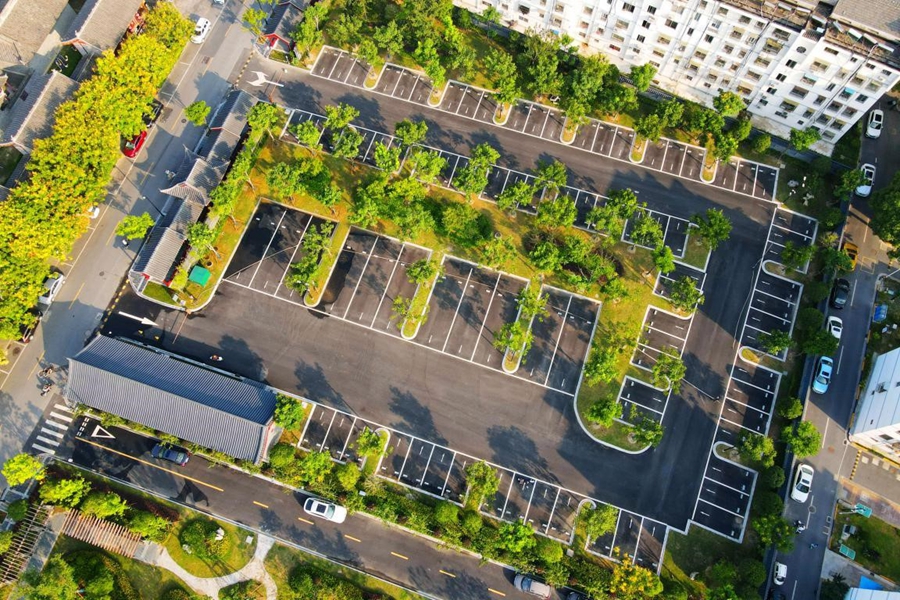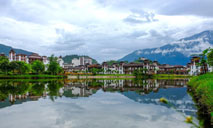China’s efforts to enhance urban water conservation pay off
 |
| Photo taken on Aug. 20, 2020 shows a “sponge parking lot” in Rugao, east China’s Jiangsu province. (People’s Daily Online/Wu Shujian) |
From 2012 to 2020, Chinese cities saved 45.3 billion cubic meters of water, which was five times the quantity transferred annually through the middle route of China's South-to-North Water Diversion Project, according to statistics released by the country's Ministry of Housing and Urban-Rural Development (MOHURD).
In China, urban water consumption only accounts for around 10 percent of the total volume consumed, but it supports 60 percent of the country's population and contributing to over 70 percent of its GDP.
China is making reclaimed water a “second source” for urban water consumption. Last year, 14.6 billion cubic meters of reclaimed water was consumed in the country's urban areas, growing fourfold from that in 2012 and accounting for 23.2 percent of total urban water supply.
In recent years, water conservation has been taken as a priority by Chinese cities in their work related to water consumption, as they strived to build an urban water system in which water supply, water environment treatment and water security are interconnected.
From a stinky ditch to a beautifully clear channel, Liangmahe River in Chaoyang district of Beijing has taken on a new look.
The clear water comes from a nearby water reclamation plant, said Zhao Tan, director of Beijing's water conservation office, adding that the water for the irrigation on the two banks of the river is also reclaimed.
An official from the MOHURD introduced that local authorities across China has been accelerating the upgrading of battered water supply networks and improving management capabilities. As a result, the leakage rate of urban water supply pipelines has been on a stable decline, the official said.
In the plant of a cement company in Yichang, central China's Hubei province, there is a huge pond. “Rainfall and rinse water stored in the pond are turned into clear water after recycling, and sent to the mixing plant for production through pipelines,” said an executive of the company. Around 80 percent of the company's water consumption is recycled, which cuts cost by more than 400,000 yuan ($62,183) each year, he said.
In recent years, the concept of sponge city has been gradually instilled into the urban planning, construction and management of many cities in China, as a way to improve their capability in utilizing, regulating and absorbing rainfall. For instance, hardened roads are replaced by permeable pavers, while grassed canals and sunken grassbelts are built to store rainfall for irrigation of treelawns.
As of the end of 2020, over 40,000 projects of sponge city construction had been completed, which can utilize 350 million tonnes of rainfall on an annual basis.
Besides, China is also actively building water-conserving cities and promoting water conservancy methods and ideas in communities to shape a green development model and lifestyle. So far, 130 cities in the country have been rated as water-conserving cities. Accounting for 58.5 percent of total urban water consumption, these cities will forcefully advancing water conservation in China's urban areas.
 |
Photos
Related Stories
- Xi Focus: China's water diversion project promotes green development
- China's Gansu improves drinking water for over 12 mln residents
- Multiple measures improve bodies of water in China’s rural areas
- Chinese premier stresses management of water diversion project
- Chinese political advisors contribute insights on water use
- Chinese company delivers clean water to local Nigerians
- China pours 20 mln USD to treat water pollution in Tibet last year
- Amazing China: The Story of Water and Stone
- Safe drinking water reaches impoverished residents in SW China
- China's overall water environment quality has continuously improved
Copyright © 2021 People's Daily Online. All Rights Reserved.










